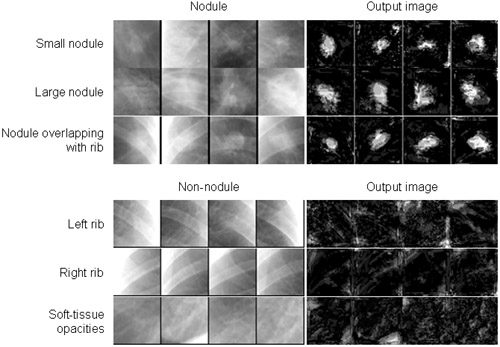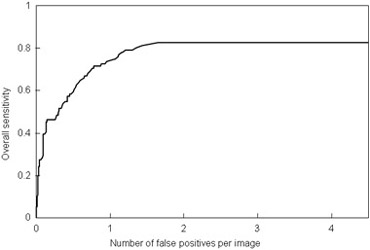False-Positive Reduction in Computer-Aided Diagnostic Scheme for Detection of Nodules on Chest Radiographs by Means of Massive-Training Artificial Neural Network (MTANN)
We developed a technique that uses a multiple massive-training artificial neural network scheme (multi-MTANN) to reduce false positives (FPs) in a computer-aided diagnostic (CAD) scheme for nodule detection on chest radiographs. Our database consisted of 91 solitary pulmonary nodules including 64 malignant nodules and 27 benign nodules in 91 chest radiographs. With our CAD scheme based on a difference-image technique and linear discriminant analysis, a sensitivity of 82.4% with 4.5 FPs per image was achieved. We developed the multi-MTANN for further reduction of the FPs. An MTANN is a nonlinear filter that can be trained with input images and the corresponding teaching images. For reducing the effects of the background levels in chest radiographs, a background-trend-correction technique followed by contrast normalization was used on the input images to the MTANN. For enhancement of nodules, the teaching image contained the distribution for a “likelihood of being a nodule.” Six MTANNs in the multi-MTANN were trained by use of typical nodules and six different types of non-nodules (FPs). In the output images of the trained MTANN, nodules are represented by light distributions, whereas non-nodules such as ribs are mostly dark. By use of the trained multi-MTANN, 68.3% of FPs were removed with a reduction of one true positive. The false-positive rate of our original CAD scheme was improved from 4.5 to 1.4 FPs per image at an overall sensitivity of 81.3%. By use of a multi-MTANN, the false-positive rate of our CAD scheme for lung nodule detection on chest radiographs was improved substantially while a high sensitivity was maintained.

Non-training nodules and the corresponding output images of the trained MTANN and various non-training non-nodules and the corresponding output images of the trained MTANN.

Free-response receiver-operating characteristic (FROC) curve of the multi-MTANN consisting of six MTANNs for 75 true positives (nodules) and 410 FPs (non-nodules).

